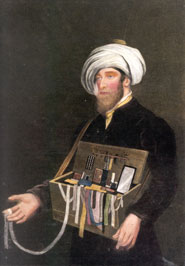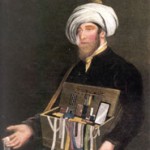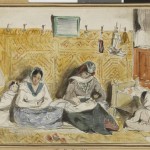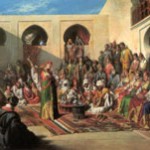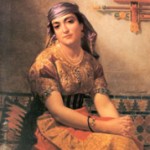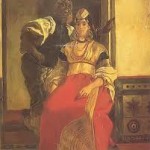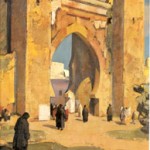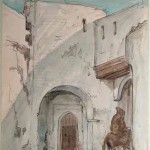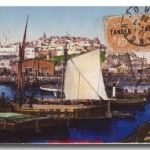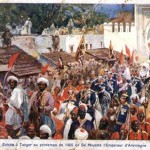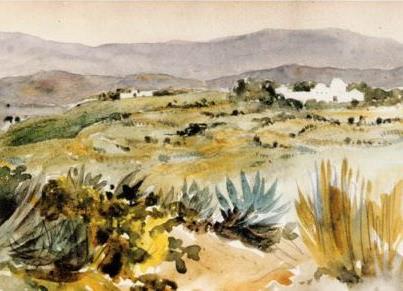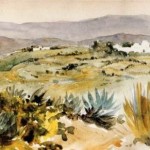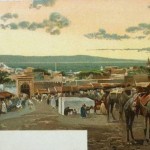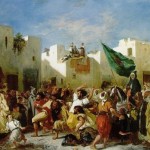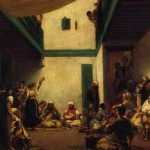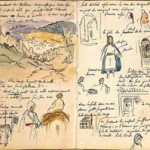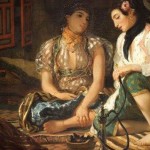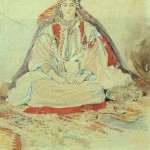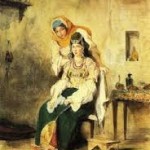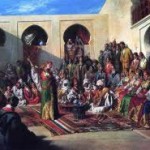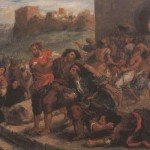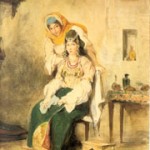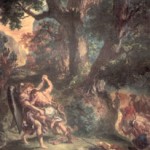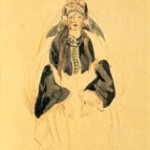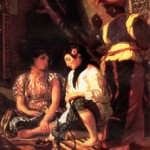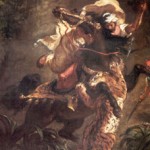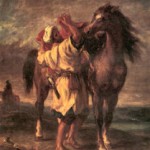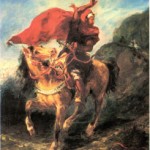Category Archives: Gallery
Delacroix, Ferdinand Victor Eugene
Profiles of Contemporary Jewish Moroccan Artists
Profiles of Contemporary Jewish Moroccan Artists
Marc Eliany ? All Rights Reserved
Introduction
From an historical perspective, much artistic merit is found in Morocco?s material culture in the work of common artisans and craftsmen.?
Western modern artists found artistic redemption in it and Moroccan Jews made a significant contribution to it in creation and diffusion (Eliany, 2002).
Given the strongly grounded traditional patterns of artistic creation in Morocco, artists had to deviate from them to break ground into modern and
contemporary art forms. But until the early 50?s, religious and traditional constraints remained potent and only sustained exposure to external cultures,
i.e., French, Israeli or North American, made contemporary artistic expressions legitimate (Eliany, 2002).
There are certainly many more artists to represent Moroccan Jewish artistic creation and in due time, more will be written about them.
Meanwhile, the three selected here, Elbaz and BenHaim on one side and Eliany on the other, certainly typify their breakthrough into contemporary art,
forgetting not their Moroccan Jewish roots.
The French influence
Around the turn of the century, Jews in Morocco became exposed to French education and French culture.
Young people went to French schools in Morocco and the brightest among them continued their studies in Europe and mostly in France.
Some, like Andre Elbaz and Maxime BenHaim, studied art in France. And their exposure to French art centers made its mark in their work.
Andre Elbaz
Leading among contemporary Jewish artists in Morocco is Andre Elbaz, born in El Jadida (Mazagan), in 1934.
He studied art and theatre in Rabat (1950-55) as well as in Paris (1957-61) and taught art in Casablanca (1962-63) (see detailed CV).
Elbaz? work depicts Jewish themes in the abstract expressionist tradition: i.e., figures in synagogue settings, tragic events such as the Holocaust
(exhibited at Yad Vashem in 1985) and the Inquisition in 1992. He worked in Morocco, Canada and France.
His most recent work vacillates between expressionistic portrayals of Jerusalem and powerful conceptual abstract work in which
he yearns to eradicate interfaith destructiveness (see sample below).
| ? Andre Elbaz in his studio | |
|
Andre Elbaz, The Prayer,
Acrylics on paper |
|
|
Andre Elbaz, Untitled, 1987,
Reconstituted tinted paper |
|
| ?
Andre Elbaz, Untitled, 1987, Reconstituted tinted paper |
Maxime Ben Haim
Maxime Ben Haim born in Meknes in 1941, studied art in Paris in the mid sixties.
He worked in Morocco, France and Canada, living in Montreal since 1979.
Ben Haim elevates the Moroccan Jewish quarter (Melah) as well as ancestral figures from common existence
to archetypal transcendence in a somewhat expressionistic/realistic style.
Ben Haim?s work is firmly grounded in Jewish roots and yet it transcends cultural boundaries,
bridging across collective memories binding Jews and Arabs across many generations
(see detailed CV as well as samples of his work attached).
| Ben Haim, Self Portrait, Acrylics on paper |
|
|
Ben Haim,
Femme de Memoire, 1988 Acrylics on paper |
|
| Ben Haim, Ombre sur la maison, 1988, Acrylics on paper |
The Israeli/North American influence
Immigration to Israel and North America exposed Jewish artists of Moroccan origin to new influences.
Pinhas Cohen Gan arrived to Israel at a very young age; nevertheless his perception of Israel has been strongly determined
by his Moroccan roots and his art education in New York.
Similarly, Marc Eliany who lived in Israel for some fifteen years, certainly absorbed Israeli influences too.
He, however, arrived to Israel at a more mature age and was able to look at Israel from a critical point of view.
Furthermore, his artistic world of concepts was shaped by a wider and universal exposure to art in
North America, Europe as well as Asia and Africa.
Pinhas Cohen Gan born in Meknes in 1942 in Meknes, immigrated to Israel in 1949,
graduating from Bezalel Art Academy (1970), the Hebrew University (1973) and Columbia University in 1977.
He was awarded the Israel Prize in 2008 for his contribution to art in Israel.
Pinhas Cohen Gan is well known as a conceptual abstract painter in Israel.
Cohen Gan juxtaposed the individual and his environment, confronting men to ?scientific? realities,
a metaphor for the alienation of newcomers from Arab countries in a ?Westernized? Israel (Fuhrer 1998; Omer 1983).
| ?Pinhas Cohen Gan | |
|
?Pinhas Cohen Gan,
Latent figurative circuit |
Marc Eliany
Marc Eliany, born in 1948 in Beni Melal, immigrated to Israel in 1961 and moved to Canada in 1976.
He was educated at the Technion (1969-71), the Hebrew University (1971-76) and Carleton and Ottawa Universities (1976-1981).
Eliany is a multidisciplinary artist and writer dedicated to documenting Jewish life in Morocco.
He wrote a collection of poems ?On Wine and Love? in the Spanish Mauresque tradition,
a play ?Rezadeira? on Spanish-Portuguese Maranos and produced photographic documentation (The Last Jews of Ifrikia)
and canvases (Gates of Welcome) conveying the wealth of Moroccan Jewish Culture, past and present (www.artengine.ca/eliany/).
Eliany addresses issues relating to inter-cultural tolerance in a symbolic expressionist fashion.
“Eliany touches the heroic, the power of the symbol? His painting reduces rhythms to their essential?
His work expresses his deep and colorful spirituality, and his fierce sensuality?? (Ouaknine, 1994).
| Eliany in his studio, 2002 Photo:C. Zacharia, Museum of Civilization, Canada |
|
|
Eliany,
Man at work, 1979, Tempera on paper |
|
| Eliany, 1992, Fes tombs, photo |
|
|
Eliany,
After the market on a sunny day, 1993, oil on canvas board |
References
Elbaz, Andre, 1971????????????????? Seuls
Elbaz, Andre, 1991????????????????? Of Fire and Exile
Eliany, Marc, 2002?????????????????? ?Artistic Creation and the Moroccan Jewish Diaspora? www.artengine.ca/eliany/
Fuhrer, Ronald, 1998?????????????? Israeli Painting, An Elephant Eye Book, New York
Omer, Mordechai, 1983?????????? Pinhas Cohen Gan 1983 Haifa Museum of Modern Art, Israel
Ouaknine, Serge, 1994???????????? Gates of Welcome, Virtual Publications, Canada
Yad Vashem, 1985????????????????? The Cry of Silence: Andre Elbaz, Yad Vashem Art Museum
www.artengine.ca/eliany/
www.maximebenhaim.ht.st
ANDRE ELBAZ
12, Rue Lagrange, Paris, 75005
33 1 46 33 25 91 elbaz.andre@gmail.com or andre_elbaz@hotmail.com
n? le 26 Avril 1934 ? Mazagan, Maroc
ETUDES : ?
Arts Graphiques et Th??tre
1957-1961?????????????? Ecole des Beaux Arts, Paris
1950-1955 ????????????? Ecole d?art graphique, Rabat
1949-1950 ????????????? Ecole d?art dramatique, Rabat
ONE MAN SHOWS :
2002??????? Galerie Mabel Semmler, Paris
La Maison de la bibliophilie, Paris
2001??????? Remember for the Future Maison Fran?aise, Oxford – Galerie La Croix Baragnon,Toulouse
2000??????? Cinq triptyques en guise de perspective – M?morial du CDJC, Paris
1999??????? Le D?fit ? la Barbarie , Mus?e D?partemental, Epinal- Biblioth?que de l?A.I.U.? Parris
1993??????? Cegep Saint Laurent, Montr?al
1992??????? Sala dei Congressi, Milano ; Casa della?? Cultura, Livorno
Ottawa Carleton Regional Center, Ottawa ;
Jewish Public Library, Montr?al
1990??????? Centre Pompidou, Biennale du Film d’Art, Paris
1990??????? Se?bu Gallery, Tokyo
1989??????? Nishi-Azabu ; Azakloth Gallery, Tokyo
1985??????? Mus?e d’Art, Yad Vashem, J?rusalem
1984??????? Galerie Aut der Land, Munich
1976??????? Mus?e de Tel Aviv
La Rotonde, Aix-en-Provence ; Centre Edmond Fleg, Marseille
Ch?teau de Herbeys, Grenoble
1975 ?????? Centre Rachi, Paris
1972??????? Albert White Gallery, Toronto
1970??????? Terre des Hommes, Montr?al
1969??????? Waddington Gallery, Montr?al
1965??????? Centre Culturel Fran?ais, Casablanca
1964??????? Zwemmer Gallery, Londres
1962-63-1965 ??????? ?Mus?e de Bab Rouah, Rabat
1960??????? Balliol College, Oxford
PRIX :
1998?????? Prix M?moire de la Shoah – Fondation du Juda?sme Fran?ais
1968 ???? La Nuit n’est jamais compl?te? Laur?at du court m?trage – V?me Biennale de Paris.
SALONS & BIENNALES :
1973????? Jean Paulhan ? travers ses peintres
1968 ???? Nuit Culturelle de Nancy avec Ro?l d?Haese, Pierre Schaeffer, Ren? de Obaldia Esposito, Piem.
1961-1963-1965-1967 ?????????? Biennales de Paris, Mus?e d?Art Moderne
1955-1959?????????????????????????????? Salon des Surind?pendants – Salon de l?Ecole Fran?aise – Salon d?Hiver
Salon de la jeune Peinture – Mus?e d?Art Moderne – Paris
COURTS METRAGES & ANIMATIONS :
1972??????? Histoire d??ufs, animation Montr?al
1971?????? Regard sur la Peinture Am?ricaine, Whitney Mus?um, New York
1970????? L?homme ? la Bouteille,? R?alise ? l?Office National du Fim Montr?al ? la demande de Norman McLaren?
Les Mobiles chez Calder, au MOMA New York?
1969 ???? Graphiques pour ? Kaddish ? de L?onard Bernstein
1966????? La Nuit n?est Jamais Compl?te, Oratorio “A Survivor from Warsaw ? Arnold? Sch?enberg,
Service de la Recherche de l?ORTF – repr?sente la France au Festival du Court-M?trage ? Tours
REALISATIONS :
1971? -? SEULS, Portfolio de 20 s?rigraphies, Textes de Elie Wiesel & Na?m Kattan.
1991?? -? DE FEU ET D?EXIL, Portefolio de 20 s?rigraphies sur le th?me de l?Inquisition, textes de Fran?ois-Marc Gagnon, Shmuel Trigano & Na?m Kattan
COLLECTION :
Biblioth?que Nationale, Paris – Public Library, New York – Biblioth?que Municipale de Montr?al? Jewish Museum, New York – Biblioth?que Nationale, Qu?bec – The National Gallery, Ottawa – Mus?e des Beaux Arts, Montr?al – Biblioh?que Municipale, Toronto – J?rusalem Museum – Tel-Aviv Museum? -? Yad Vashem Museum of Art, Jerusalem – Biblioth?que de l’Universit? de Toronto – Biblioth?que de l?Assembl?e Nationale, Paris – Mus?e des Deux Guerres, Paris – Minist?re de la C:ulture, Paris – Mus?e de la D?portation, Paris Mus?e d?Art et d?histoire du Juda?sme, Paris – Biblioth?que, Toronto – Jewish Seminary, New York – Biblioth?que de l?Alliance, Paris – Wienner Libary, London – Jewish Museum, Copenhague
S.A.R. La Princesse Elisabeth du Danemark – Willy Brandt – Itshack Rabbin – Mme A. de Rothschild – Elie Wiesel – Bronfman Family – M . & Mme L?on Cligman et d?autres collectionneurs priv?s, U.S.A., Canada, Europe, Isra?l, France, Suisse, Maroc.
Art in the Moroccan Jewish Diaspora
Abstract
Modern art historians suggested that there was hardly any art tradition in Morocco. Putting things in perspective, this article demonstrates that much artistic merit is found in Morocco?s material culture, many Western modern artists found artistic redemption in it and Moroccan Jews made a significant contribution to it in creation and diffusion.
Introduction
Modern art historians may suggest that there was hardly any art tradition in Morocco. For in their eyes, Morocco was far from European influential art centers and much of the esthetic creation was not intended for artistic but utilitarian purposes. And yet much artistic merit is found in utilitarian objects that make Morocco?s material culture (Grammet, 1998).
The sense of esthetics is so omnipresent in Morocco that sensitive observers cannot discount it. It is present in structural and landscape architecture in urban centers such as Fez as well as remote villages high on the Atlas Mountains and further South deep in desert lands (Cherraddi, 1998). And it resurfaces in mosaics, sculpted surfaces (Grammet, 1998), stained-glass, illuminations of poetry and religious books as well as documents such as marriage contracts, tents (Sorber, 1998), carpets (Boely, 1998), curtains, bed covers, clothing (Sorber, 1998), musical instruments (Olsen, 1998), jewelry (Grammet, 1998), pottery (Martinez-Servier, 1998; Camps, 1961), ornaments of religious and secular values and much more?(Lovatt-Smith, 1995)
The sense of esthetics was (and remains) so pervasive in Morocco that it inebriated modern art pioneers such as Delacroix, Ferdinand Victor Eugene (1798-1863). Delacroix, a romantic painter, inspired by both classical and Medievial art, opened the gate to impressionism by introducing into European art the vivid colors of the Maghreb. Traveling in North Africa in 1832, he stopped in Tangier, Meknes and Algier. And moved by Jewish and Arab beauty, he produced masterpieces depicting the essence of Moroccan esthetics, including interiors of Jewish homes and portraits of Jewish women, which appeared in his eyes beautiful and charming and their costumes dignified and graceful. And so, observations of daily life in Morocco elevated Delacroix?s pictorial work to a classicism long lost in Europe. Following Delacroix, many artists, including Matisse, went on pilgrimages to Morocco, most searching for artistic redemption in the exotic, colorful and sensuous (Arama, 1991; Cowart et. al. 1990).
And the influence of Moroccan esthetics did not stop at the gates of the exotic. It inspired abstract contemporary art in the work of Le Corbusier and Kadinski, who evidently borrowed from Berber geometrical forms? (Minges, 1996: 20-21). These geometrical forms found in architectural design, carpets, ceramics and jewelry, were often spontaneous bursts of artistic creativity among Moroccan creators. And their compositions remain astonishingly modern, clearly preceding the abstraction that became the foremost characteristic of modern art (Boely, 1998: 121 and Lehman, 1998).
But what did Moroccan Jews do to depict themselves?
Oral traditions convey persistently that Jewish life in Morocco goes back to Biblical times. Some say that artisans came to Morocco as early as 950 BCE during the reign of King Salomon, perhaps as his artisan emissaries and perhaps to escape his oppressive rule (see hints to Ethiopian migration in Roger, 1924). And successive waves of Hebrews immigration followed one another in conjunction with major historical population movements (i.e., with the Phoenicians or after the destruction of the First Temple) and displacements (i.e., Romans sold Jews as slaves all across the Empire). One way or another, Moroccan Jews believe that they laid the foundation to arts and crafts in Morocco since antiquity (Skounti, 1998; Chouraqui, 1985; Zafrani, 1983) and some research lends credence to this belief (Grammet, 1998; Camps, 1961; Elkhadem, 1998).
Expressions of artistic creation
Jewish artistic expressions are evident in structural and landscape architecture, mosaic and pottery, sculpted surfaces on wood, clay and plaster, stained-glass, carpets, curtains, bed covers, clothing, embroidery, leatherwork, illuminations of poetry and religious books as well as documents such as marriage contracts, musical instruments, jewelry and metalwork, ornaments of religious and secular values and much more? All these may be considered as minor arts forms in Western lands but not so in Jewish and Muslim Morocco, where religion defined the meaning of life (Swarzenski, 1967).
Merchandising artistic creation
But Jewish influence in the arts did not stop at the actual act of artistic expression in Morocco. Jews played an important role in commerce and international relations and thus were a principal vehicle of transmission of ideas relating to artistic tastes. They introduced Moroccan objects of artistic merit to foreigners and thereby had a significant influence on local demand and production of these objects. Jewish impact on artistic/esthetic tastes was not limited to bridging between Europe and Morocco but also between Morocco and Africa. For Jews dominated trans-Saharan commerce until the capture of Timbuktu by the French in 1894? (Grammet, 1998: p. 216).
Jewelry, metalwork and gold and silver embroidery creation
It is common knowledge that Moroccan Jews dominated jewelry since centuries and metalwork (i.e., silver amulet, Hanukah lamps, copper trays) and some of their work was refined and exquisite in its artistic beauty (Grammet, 1998; Africanus, 1556). But less known is their leadership in gold and silver embroidery for secular uses (i.e., clothing for the Christian and Moroccan elite) and ceremonial uses (i.e., Torah mantle and wedding dresses) (Mann, 2000, Sorber 1998:182-183).
????? Jewish jeweler, Bni Sbih, Dra Valley,
Jean Besancenot, 1934/39, Institut du Monde Arabe, Paris
???????? Silver Amulet with star of David, private collection
????? Hanukah lamp, private collection
Copper tray with star of David, private collection
?Torah mantles, Beth El synagogue, Casablanca
?????? Gold and silver embroidered wedding dress, Sale
Young woman in traditional wedding dress Jeune Jean Besancenot, 1934/39,
Institut du Monde Arabe, Paris
In the case of jewelry, some suggest that after the departure of Moroccan Jews, the quality of jewelry declined, especially in rural center of production and in many cases, rural jewelry production disappeared completely (Grammet, 1998). Some also suggest that a significant Spanish/Moorish influence is noticeable in Jewish Moroccan jewelry in terms of design and techniques due to the contribution of the Spanish/Portuguese refugees after the expulsion from Spain (Gonzales 1994, Flammant 1959).
It is common, for example, to find the Star of David in Moroccan jewelry (i.e., on Ahl Massa, Royal Museum of Central Africa, RMCA, Belgium) but Moroccan jewelry had very specific Jewish characteristics too.? Headdresses of Jewish women in Southern Morocco were different from those of their neighbors due to edicts of hair concealment. In this particular case, head dresses consisted of colorful material (foulard) on which jewelry was set (Grammet, 1998: p. 336, i.e., Jewish women of Tahala of Besancenot, 1934/39, Institut du monde Arabe, Paris). In some cases, head dresses consisted of hair too (Morin-Barde, 1998: p.346).
??????????? Jewish women of Tahala of Besancenot, 1934/39,
Institut du monde Arabe, Paris
Architectural elements and sculpted surfaces
Synagogues tended to be modest on their outside but quite impressive inside. There were large glass vases set in metal ornaments (see memorial vase, Ben Saadoun synagogue, Eliany), illuminated manuscripts and amulets (see amulet, Ben Saadoun synagogue, Eliany), Torah mantle (Torah mantle, Ben Saadoun and Beth El synagogues, Eliany), Heichal curtains/cover (Ben Saadoun synagogue, Eliany). All these were well mentioned (i.e., Mann, 2000) but little was said about architectural elements and sculpted surfaces in synagogues and interiors of Jewish homes. Surely, Jews in Morocco shared much with their neighbors but there was enough to distinguish them too. For illustration purposes, the interior of the Ben Saadoun synagogue in Fes regroups elements that typify the finest of Jewish interiors in Morocco. Several of its walls and parts of its ceilings are made of sculpted plaster (interior, Ben Saadoun synagogue, Eliany) and a series of stained glass windows crown its upper ceiling (stained glass, Ben Saadoun synagogue, Eliany). In many cases, interiors were striking in their design sophistication in synagogues as well as in private homes (interior of Dahan synagogue in Fes, Eliany).
|
?
?Memorial vase, Ben Saadoun synagogue, 1992
? Heichal curtains/cover Ben Saadoun synagogue, Fes
?Sculpted interior, Ben Saadoun synagogue, Fes
?Stained glass, Ben Saadoun synagogue, Fes
? Interior of Dahan synagogue in Fes
Illuminated manuscripts
Manuscript illumination was widespread in Morocco, especially in Coranic contexts but also in amulets used in popular rites (Elkhadem, 1998). In this sense, Moroccan Jews had much to share with their Moslem neighbors. But unlike their Moslem neighbors, much of the artistic creation in the form of illuminations of manuscripts and amulets disappeared or was destroyed.
?Amulet, Ben Saadoun synagogue, 1992
Jews illuminated marriage contracts (Meknes, Gross collection in Mann, 2000) and Passover Haggadoth most frequently. But occasionally, they also illuminated other Biblical passages, i.e., the Book of Esther which gained special significance following the 1492-1497 expulsion and conversion events in Spain and Portugal.
? Illuminated marriage contracts, Meknes
Similarly, Jews played a significant role in folk medicine, writing amulets to heal Jews and non-Jews or bring upon them blessings and good luck. For this purpose, Jews illuminated amulets on paper, leather, textiles, clay and other metals. Some of the amulets were small, designed for individual and private use but some were displayed for all to see in synagogues and private homes (Mann, 2000; see amulet, Ben Saadoun synagogue above, Eliany).
Pottery and stone sculpting
Jewish women made pottery to satisfy their basic needs for the most part but occasionally they did produce some for neighbors and friends and possibly for sale in neighboring markets (Decorative fruit tray and pottery in the market place, Eliany). Most of the pottery making was done from local clays using modeling techniques, without a potter?s wheel. Deriving clay from a riverbank and fashioning it was associated with the act of creation and was often considered a sacred act of a mythical dimension (Martinez-Servier, 1998).
?Decorative fruit tray, Ouarzazat
? Pottery in the market place, Sale
Jewish men were rarely involved in pottery making but it is not inconceivable that there were Jewish potters at one time or another. Men in Morocco often used potters wheels and according to some, Phoenicians introduced local inhabitants to it (Camps, 1961). It is also very likely that men sculpted stones, although it is rarely mentioned in art reviews.
Forms and decoration of Moroccan pottery and sculpted stone are loaded with meanings and symbolism, which according to some go back to prehistoric periods and may have special significance to archeological research (Martinez-Servier, 1998). Some of the symbols and decoration found on Moroccan pottery have been associated with Nabathian writing (Elkhadem, 1998). Some oil lamps, for example, resemble ancient Hebrew lamps and their forms may date back to Biblical/Roman times (i.e., ancient oil lamps sculpted in stone, private collection, Eliany). Decorations may be painted (butter pot, Batha museum, Fes), engraved (engraved plate, private collection, Eliany) or sculpted on a pottery surface (RMCA, Belgium).
Art reviewers tend to emphasize utilitarian use to diminish artistic merit (i.e., oil lamps) while artistic merit is understated or ignored in cases where utilitarian use was not intended, i.e., stone sculpting (for example: Man and Wife and warrior, below).
????? Ancient ceramic oil lamp, private collection
????? Ancient stone sculpted Hanukah lamp, private collection
?Ancient stone sculpted Shabbat lamp, private collection
????? Ceramic butter shop, Batha museum, Fes
??????????? Engraved ceramic plate, private collection
????? Pottery with sculpted surface RMCA
??????????? Stone sculpted man and wife, private collection
????? Stone sculpted warrior, private collection
Contemporary art expressions
Given the overpowering traditional cultural setting which provided the context for the artistic expression of Moroccan Jews, it is interesting to explore how and when the Moroccan Jewry wandered into contemporary form of art.
It is clear that in spite of the encounter with visiting artists such as Delacroix, Western art left little impression on Moroccan artists, probably because the world of meanings of Moroccan Jews remained bound by religious constraints. In this sense, a significant breach had to occur in Morocco for artistic creation per se to detach itself from artistic creation in its craft form. Given the strongly grounded traditional patterns of artistic creation in Morocco, an artist had to deviate from them to break ground into modern and contemporary art forms. But until the early 50?s, religious and traditional constraints remained potent and only sustained exposure to external cultures, i.e., French, Israeli or North American, made contemporary artistic expressions legitimate.
In this context, contemporary art expressions have gained ground in Morocco even if they did not detach themselves completely from the world of colors and symbolism in which they were born and which served a fertilization ground to Modern artists from Delacroix through Matisse and Kadinski. As Moroccan painters broke grounds into contemporary art forms of expression, they found themselves on a perennial crossroad, the crossroad where North and South or East and West met since many centuries.
The French influence
The exposure to French art centers is noticeable in the work of Elbaz and BenHaim.
Leading among contemporary Jewish artists in Morocco is Andre Elbaz, born in El Jadida (Mazagan), in 1934. He studied art and theatre in Rabat (1950-55) as well as in Paris (1957-61) and taught art in Casablanca (1962-63).
??? Andr? Elbaz in his studio
His work depicts Jewish themes in the abstract expressionist tradition: i.e., figures in synagogue settings, tragic events such as the Holocaust (exhibited at Yad Vashem in 1985) and the Inquisition in 1992.
???? Gouache on paper, Andr? Elbaz
Living in Paris, his most recent work vacillates between expressionistic portrayals of Jerusalem and powerful conceptual abstract work in which he yearns to eradicate interfaith destructiveness.
? Untitled, Andr? Elbaz, colored paper paste, 1987
Maxime Ben Haim born in Meknes in 1941, studied art in Paris in the mid sixties, lives in Montreal since 1979.
??? Maxime Ben Haim self portrait, acrylics on paper
Ben Haim elevates Moroccan the Jewish quarter (Melah) as well as ancestral figures from common existence to archetypal transcendence in a somewhat expressionistic/realistic style.
???? Miriam, 1988, Acrylics and oil on paper, 61×56 cm.
??? House in a shadow, 1988
?????????????????????????????????????????????????????? Acrylics and oil on canvas, 109x130cm,
Ben Haim?s work is firmly grounded in Jewish roots and yet it transcends cultural boundaries, bridging across collective memories binding Jews and Arabs across many generations.
The Israeli/North American influence
Pinhas Cohen Gan born in Meknes in 1942 in Meknes, immigrated to Israel in 1949, graduating from Bezalel Art Academy (1970), the Hebrew University (1973) and Columbia University in 1977.
????? Pinhas Cohen Gan, photo of Liora Laor
??????????? Latent figurative circuit, 1977,
Acrylic and oil on a sheet and a cardboard
30x32x218 cm.
Pinhas Cohen Gan is well known as a conceptual abstract painter in Israel. Cohen Gan juxtaposed the individual and his environment, confronting men to ?scientific? realities, a metaphor for the alienation of newcomers from Arab countries in a ?Westernized? Israel (Fuhrer 1998; Omer 1983).
Marc Eliany, born in 1948 in Beni Melal, immigrated to Israel in 1961 and moved to Canada in 1976. He was educated at the Technion (1969-71), the Hebrew University (1971-76) and Carleton and Ottawa Universities (1976-1981).
? ????????? Eliany in his studio, Photo of Camille Zakharia,
??????????????????????????????????????????????????????????? Museum of Civilization, Gatineau, Canada
Eliany is a multidisciplinary artist dedicated to documenting Jewish life in Morocco. He addresses issues relating to inter-cultural tolerance in a symbolic expressionist fashion.
??????? Man at work, 1977, Gouache on cardboard, 50x70cm
??? After the market on a bright sunny day, 1994
??????????????????????????????????? Acrylics and oil on canvas board, 50×60 cm
?“Eliany touches the heroic, the power of the symbol? His painting reduces rhythms to their essential? His work expresses his deep and colorful spirituality, and his fierce sensuality?? (Ouaknine, 1994).
Discussion
From an historical perspective, much artistic merit is found in Morocco?s material culture in the work of common artisans and craftsmen.? Western modern artists found artistic redemption in it and Moroccan Jews made a significant contribution to it in creation and diffusion. Given the strongly grounded traditional patterns of artistic creation in Morocco, artists had to deviate from them to break ground into modern and contemporary art forms. But until the early 50?s, religious and traditional constraints remained potent and only sustained exposure to external cultures, i.e., French, Israeli or North American, made contemporary artistic expressions legitimate. There are certainly many more artists to represent Moroccan Jewish artistic creation and in due time, more will be written about them. Meanwhile, the four selected here, Elbaz and BenHaim on one side and Cohen-Gan and Eliany, on the other side, certainly typify the breakthrough into contemporary art, forgetting not their roots.
References
Africanus, Leo, 1556??????????????? Description de l?Afrique, Lyons
Arama, Maurice, 1991 ??????????? Itineraires Marocains, Jaguar, Paris
Boely, G?rard, 1998???????????????? Les Tapis du Moyen Atlas dans Splendeurs du Maroc, Musee Royal de l?Afrique Centrale, Tervuren
Camps, G. 1961?????????????????????? Monuments et rites funeraires protohistoriques
??????????????????????????????????????????????? Arts et M?tiers graphiques, Paris
Cherraddi, Cadre, 1998?????????? Les Kasbah du Sud dans Splendeurs du Maroc, Musee Royal de l?Afrique Centrale, Tervuren
Chouraqui, Andr?, 1985?????????? Histoire des Juifs en Afrique du Nord, Hachette, Paris
???????????
Cowart et al. 1990?????????????????? Matisse in Morocco 1912-1913
??????????????????????????????????????????????? National Gallery of Art, Washington
Elkhadem, Hossam, 1998???????? Les Manuscrits dans Splendeurs du Maroc, Musee Royal de l?Afrique Centrale, Tervuren
Flammant, P., 1959????????????????? Les communautes Israelites du Sud-Marocain,
Imprimerie reunites, Casablanca
Fuhrer, Ronald, 1998?????????????? Israeli Painting,
An Elephant Eye Book, New York
Gonzales, V., 1994?????????????????? Emaux d?Al Andalus et du Maghreb,
Edisud, Aix en Provence
Grammet, Ivo, 1998???????????????? L?esthetique de la culture materielle? dans Splendeurs du Maroc, Musee Royal de l?Afrique Centrale, Tervuren
Grammet, Ivo, 1998???????????????? Les tapis du Haouz dans Splendeurs du Maroc, Musee Royal de l?Afrique Centrale, Tervuren
Grammet, Ivo, 1998???????????????? Les bijoux dans Splendeurs du Maroc, Musee Royal de l?Afrique Centrale, Tervuren
Grammet, Ivo, 1998???????????????? El?ments d? architecture et mobilier en bois dans Splendeurs du Maroc, Musee Royal de l?Afrique Centrale, Tervuren
Lehman, Zineb, 1998??????????????? Le Tapi Ouaouzguite dans Splendeurs du Maroc, Musee Royal de l?Afrique Centrale, Tervuren
Lovatt-Smith, Lisa, 1995 ???????? Moroccan Interiors, Taschen, NewYork
Mann, Vivian B., 2000???????????? Morocco, Jews and Art in a Muslim Land,
Merrel and the Jewish Museum of New York, New York
Martinez-Servier N. 1998???????? La poterie dans Splendeurs du Maroc, Musee Royal de l?Afrique Centrale, Tervuren
Minges, K., 1996???????????????????? Berber Teppiche und Keramik. Museum Bellerive, Zurich
Morin-Barde, Mireille, 1998???? Coiffures, maquillages et tatouages dans Splendeurs du Maroc, Musee Royal de l?Afrique Centrale, Tervuren
Olsen, Rovsing, M., 1998???????? Traditions Musicales de la Montagne dans Splendeurs du Maroc, Musee Royal de l?Afrique Centrale, Tervuren
Omer, Mordechai, 1983?????????? Pinhas Cohen Gan 1983
??????????????????????????????????????????????? Haifa Museum of Modern Art, Israel
Ouaknine, Serge, 1994???????????? Gates of Welcome, Auberge des Arts Virtual Publications, Canada
Roger, R. 1924??????????????????????? Le Maroc chez les auteurs anciens, Les Belles Lettres, Paris
Skounti, Ahmed, 1998????????????? Introduction Historique dans Splendeurs du Maroc, Musee Royal de l?Afrique Centrale, Tervuren
Sorber, Frieda, 1998??????????????? La tente dans Splendeurs du Maroc, Musee Royal de l?Afrique Centrale, Tervuren
Sorber, Frieda, 1998??????????????? Technologie dans Splendeurs du Maroc, Musee Royal de l?Afrique Centrale, Tervuren
Sorber, Frieda, 1998??????????????? Les textiles d?ameublement dans Splendeurs du Maroc, Musee Royal de l?Afrique Centrale, Tervuren
Sorber, Frieda, 1998??????????????? Les vetements dans Splendeurs du Maroc, Musee Royal de l?Afrique Centrale, Tervuren (pp.182-183).
Swarzenski, Hanns, 1967 ??????? Monuments of Romanesque Art, Chicago University Press, Chicago
Zafrani, Haim, 1983????????????????? Milles ans de vie juive au Maroc. Maisonneuve et Larosse, Paris
Other sources:
Andre Elbaz, 1971?????????????????? Seuls
Andre Elbaz, 1991?????????????????? Of Fire and Exile
Expsotions – Eliany Marc
Eliany – Expositions
2007 – 2010 Haela Art Center, Israel
2007 Galeria Cavendish Mall, Cote St Luc, Quebec
2006 Galeria Cavendish Mall, Cote St Luc, Quebec
2005 McMichael Collection d’Art Canadien
2005 Archive National, Ottawa, Canada
2005 Galeria Cavendish Mall, Cote St Luc, Quebec
2005 Cube Galerie, Ottawa, Canada
2004??? Michele Villeneuve Galerie d?art , Ottawa, Ontario, Canada,
2004 St Andrews Open Art Studio (exposition permanente)
2003??? Michele Villeneuve Galerie d?art , Ottawa, Ontario, Canada,
2003 Musee de la Nature, Ottawa, Canada
2003 COAT, studio ouvert, artistes d?Ottawa centre
2003 Billings Museum Art Fair, Ottawa, Canada
2002??? Universit? Ben Gurion, Beer Sheva, Israel (exposition, lecture de Resadeira, conference)
2002 Auberge des Arts, Montpellier, Quebec (exposition continue)
2002 Mus?e des Civilisations, Ottawa, Canada (Ces pays qui m?habitent)
COAT, studio ouvert, artistes du center d?Ottawa
2001??? Mus?e des Civilisations, Ottawa, Canada (Ces pays qui m?habitent)
2001 Galerie Saw, Ottawa, Canada
2001 Recycl’art, Argenteuil, Quebec
2001 Beaver College Fine Art Gallery, MD, USA
2000??? Mus?e Galerie, Colonie des artistes de Safed, Israel
2000 Mus?e contemporain de Baltimore, MD, USA???????
1999??? Galerie 101, Ottawa, Canada (Artistes contre la Violence)
1999 Collected Works, Ottawa, Canada (NOK, Artistes Africains)
1999 Parlement du Canada, Ottawa, Canada (Artistes contre le racisme)
1998??? CCIBB, Paris (Boulogne), France
1997? ? Enriched Bread Artists Gallery, Ottawa, Canada, collaboration avec
?Art sur la rue Preston? et l?Association des marchants de la rue Preston et la semaine des vendenges (La Vendemia)
1997 Z?rich Kosmos Galerie, Vienne, Autriche (parrain? par la companie d?assurance Z?rich)????????????????
1996??? Kasbah, Ottawa, Canada
1995??? 67eme competition international,
Association des art de la galerie Harrisburg, Harrisburg, Pennsylvanie??
1994??? 29th competition international, The Fine Arts Institute, San Bernardino, County Museum, Californie?
1994 Alvan G. and Carol J. Lampke prize,? New Heaven, Connecticut. USA
1994 Hilton, Vienne, Autriche (parrain? par l?embassade du Maroc)
1994 Galerie in der Sterngasse, Vienne, Autriche
1994 Palais Clam Gallas, Vienne (parrain? par les embassades de la France et du Maroc)
1994 Galerie Karl Strobl, Vienne, Autriche (parrain? par l?institut Afro-Asiatique)
1985???? Centre de conference de Winnipeg, Canada
1985 Universit? Carleton, Ottawa, Ontario, Canada??
1980?? JCC, Ottawa, Ontario, Canada
1979???? Fine things Gallery, Fournier, Ontario??????????
Correspondence:
67 Chesterton drive,
Ottawa, Ontario, Canada K2E 5T4
eliany.marc@gmail.com
Websites:
www.artengine.ca/eliany/
www.virtualpublications.ca
www.civilization.ca/expo/eliany/
skype eliany10
Exhibitions – Eliany Marc
2013 – 2006 Haela art centre, Haela art association, Israel
2010 Chelsea Gallery, London, England
2010 – 2006 Havaya art centre, Haela art association, Israel
2010 – 2005 Galeria Cavendish Mall, Montreal, Canada (www.virtualpublications.ca)
2005 McMichael Collection d’Art Canadien
2005 National Archive, Ottawa, Canada
2005 Cube Gallery, Ottawa, Ontario, Canada
2004 – 2003 Michele Villeneuve Art Gallery, Ottawa, Canada
2004 St Andrew’s Open Art Studio (Ongoing exhibition)
2003 Museum of Nature, Ottawa, Canada
2003 – 2002 COAT, open studio, part of central Ottawa artists tour
2003 Billings Museum Art Fair, Ottawa, Canada
2002 Ben Gurion University, Beer Sheva, Israel (exhibition, reading of play Resadeira, lecture)
2002 Auberge des Arts, Montpellier, Quebec (ongoing exhibition)
2002 – 2001 Museum of Civilization, Ottawa, Canada (Lands within me)
2002 COAT, open studio, part of central Ottawa artists tour
2001 Saw Gallery, Ottawa, Canada (part of fund raising event)
2001 Recycl’art, Argenteuil, Quebec
2001 Beaver College Fine Art Gallery
2000 Museum Gallery, Safed Artist Colony, Israel
2000 Contemporary Museum, Baltimore, MD, USA
1999 Gallery 101, Ottawa, Canada (part of Artists Against Violence Exhibition)
1999 Collected Works, Ottawa, Canada (part of NOK, African Artists Exhibition)
1999 Parliament of Canada, Ottawa, Canada (Artists Against Racism Exhibition)
1998 CCIBB, Paris, France
1997 Enriched Bread Artists Gallery, Ottawa, Canada in collaboration with:
1997 Art on Preston Street and the Association of Preston Street Merchants and the Vendemia
1997 Zürich Kosmos Galerie, Vienna, Austria (sponsored by Zürich Insurance Europe)
1996 Kasbah, Ottawa, Canada (part of art in living spaces)
1995 67th annual competition, The art association of Harrisburg Gallery, Harrisburg, Pennsylvania
1994 29th International competition, The Fine Arts Institute, San Bernardino, County Museum, California
1994 Alvan G. and Carol J. Lampke prize, New Heaven, Connecticut.
1994 Hilton, Vienna, Austria (sponsored by the Embassy of Morocco)
1994 Galerie in der Sterngasse, Vienna, Austria
1994 Palais Clam Gallas, Vienna (sponsored by the Embassies of Morocco and France)
1994 Galerie Karl Strobl, Vienna, Austria (sponsored by the Afro-Asian Institute)
1985 Conference Centre, Winnipeg, Canada
1985 Carlton University, Ottawa, Ontario, Canada
1980 JCC, Ottawa, Ontario, Canada
1979 Fine things Gallery, Fournier, Ontario
See Reviews
Community Art projects
1979 Established the Fine Things Gallery in Fournier, Ontario, a rural artists collaboration project in Prescott Russell, East of Ottawa
1980-1981 Contributed to Big Brothers Annual Art auction, Ottawa, Canada
1996-1997 Initiated Art on Preston Street in collaboration with the Preston Street Merchants association and the Vendemia Week, Ottawa, Canada
1997-1999 contributed to the development of NOK, African Artist Association,
Ottawa, Canada, acted as Secretary of the Association
1997-2000 Contributed and led the development of Crazy About Art in collaboration with the Canadian Mental Health Association (CMHA), Ottawa, Canada. Crazy About Art is an ongoing art therapy program based in Ottawa and managed by CMHA.
1997-2000 Contributed to United Way and CCOC art for fund raising development project
1997-2000 Contributed to Artists Against Racism, Ottawa, Canada
1998 Contributed to Artists against Violence, Ottawa, Canada
2001-2002 Contributed to Lands within Me, artists from Arab Lands established in Canada
1980-2002 ongoing community project documenting Jewish Life in an Arab Land (Morocco) in painting, writing, research, photography and video (see website www.artengine.ca/eliany/ for more publications and related exhibits).
2000-2002 Contributed to a round table committee for art development in la Petite Nation Region, North East of Ottawa. Contributed to a round table committee on the use of art for development of tourism in la Petite Nation Region, North East of Ottawa.
2002 Invited artist to Ben Gurion University, inaugurated “The Last Jews of Ifrikia” exhibition, launched a reading of the play “Rezadeira” and delivered a lecture on the documentation of Jewish community life in Morocco.
2003 Invited to Auckland, New Zealand to exhibit and deliver two lectures:
“Artistic creation and the Moroccan Jewish Diaspora” and “Burial Practices and the Fes Jewish Cemetery” two art and photography research projects. (see website www.artengine.ca/eliany/ for more publications and related exhibits).
2002-2003 Contributed to the Ben Zvi Diaspora Research Institute publication “The Moroccan Jewry” (Profiles of Jewish Moroccan Artists (article), Moroccan Landscapes (photos), Jewish life in Morocco (photos) (see website www.artengine.ca/eliany/ for more publications and related exhibits).
2000-2003 Established an artist residence program Auberge des Arts at Lake Schryer, North East of Ottawa.
2003 Contributor to COAT, Center Ottawa Art Tour.
Collections
Private collections in Canada, Austria, Israel, Danemark, Belgium, France, China.
Austria Karin Fuessl,Cecile Dujardin, Dr Nichola Wochins, Franz Maur, Chen Xi, Dr. Gabriele Kohlbauer, Musee Juif de Vienne,
Institut Afro-Asiatique, Zurich Cosmos Corp.
Canada Gillette Trickey, Johanne Trickey, Societe Gama, CCOC, Robert Trepanier, Katherine Palmer, Carole Toone, Arthur and Rivka Waas, Genevieve Trickey, Steve Schreiber, Camille Zakharia, Louise Dupont, Ellen Rasnikoff, Joseph Levy, Dr. Leo Gaudet, Dr. Chantal Whelan, Lynda Bernfeld, Joseph Cohen, Mahnaz Tarkipour, Marcel Plamondon, Jacques Charboneau, Evie Duhard, Nicole Gagnon, Monique Landry, Aron Zohar
Marocco Sa Majeste le Roi du Maroc, Hassan II, Ambassade du Maroc a Vienne, Autriche, M. El Fassi Fihri, amb. du Maroc a Vienne, M. Ben Moussa, amb. du Maroc a Vienne
Israel Nathan Acoca, Rony Acoca, Yaron Scharlitz, Simon Lahyani, Pnina Shuruk, Margalth Scharlitz, Idith Shreier, Nicole Lankri, Miriam Bouzaglo, Samy Eliany, David Eliany, Yitschak Kerem, Shoshana Gueta
Belgium Ignace et Jacqueline Dujardin
France Philipe Levy, Helene Kutner
Senegal Mamadou Seck
Danemark Lars Peterson
USA Stephan Dupont et TJ Shia, Eliyakim and Toby Frank, Adam and Elizabeth Frank
Reviews abstracts
“Marc Eliany touches the heroic, the power of the symbol. His painting reduces rhythms to their essential. From his native Morocco, he does not paint the concrete object but powerful symbols, a transformation of his childhood milieu. In his allegory on canvases, Marc Eliany, does not express nostalgia but a desire to repossess the doors, the walls and landscapes of his native Morocco. His work expresses his deep and colorful spirituality, and his fierce sensuality.” (review from Gates of Welcome by Dr Serge Ouaknine, Universite du Quebec 1994)
“In his exhibition ‘Eroba Eroba’, Marc Eliany uses colors and forms as symbols to tell a story about Europe from a non-European point of view. He expresses: hope for a better future. deception… persecutions… and he turns back to hope… Using a language of Symbolic Expressionists, this artist tells a painted tale in which he bridges between two worlds” (Exerts from a review of Eroba Eroba by Dr Gabriele Kohlbauer, Vienna Jewish Museum, 1997)
For full reviews see website: www.artengine.ca/eliany/
Studies
A graduate in personnel management (Technion 1979), social sciences (Hebrew University of Jerusalem BA 1974, MA 1976), Carleton University in Ottawa, Canada (Doctorat 1976-1980) and University of Ottawa (Diplomes 1985). Published extensively in the area of Health Studies in Canada (1989-1996). Auto-didactic in the area of the arts, studied at the Tel Hay College of Art in Israel (1966) and the School of Art in Ottawa (1985), worked intermittently with other artists in Canada, France, Austria, Israel and Morocco.
Member of Saw Video, Art Engine, COAT Central Ottawa Artist Tour in Ottawa Canada, Recycl’Art of Quebec, CARFAC.
Involved in art and tourism initiatives in Israel and Canada.
Born March 26, 1948 in Beni Mellal, Morocco.
For detailed education and professional qualifications see life CV in www.artengine.ca/eliany/
Correspondence:
Correspondence:
67 Chesterton drive, Ottawa, Ontario, Canada K2E 5T4 1 613 800 9030
15 Moshav Sedot Micah, Doar Na Haela 99810 Israel
Websites:
www.artengine.ca/eliany/
www.virtualpublications.ca
www.civilization.ca/expo/eliany/
www.jewishmoroccanarchive.co
Education (Francais)
Eliany, Marc
Etudes????????????????????
Etudes en sciences sociales ? l’universit? de J?rusalem (BA 1974, MA 1976), Universit? Carleton ? Ottawa (Doctorat 1976-1980) et l?universit? d?Ottawa (Diplomes 1985). Multiples publications acad?miques au Canada (1989-1996) et au Nations Unies (1993-1996). Etudes au college d’art de Tel Hay en Israel (1966) et ? l’?cole des arts ? Ottawa? (1985) en plus de travail intermittent avec d’autres artistes au Canada, en Autriche, France, Maroc et Israel.?N? le 26 mars 1948 ? Beni Mellal, Maroc.
(Plus de detailes dans life C.V. en Anglais).
Correspondence
67 Chesterton drive,
Ottawa, Ontario, Canada K2E 5T4
eliany.marc@gmail.com
Websites:
www.artengine.ca/eliany/
www.virtualpublications.ca
www.civilization.ca/expo/eliany/
Recherche sur internet: ‘eliany’
skype eliany10
Art Education
A graduate in personnel management (Technion 1979), social sciences (Hebrew University of Jerusalem BA 1974, MA 1976), Carleton University in Ottawa, Canada (Doctorat 1976-1980) and University of Ottawa (Diplomes 1985). Published extensively in the area of Health Studies in Canada (1989-1996). Auto-didactic in the area of the arts, studied at the Tel Hay College of Art in Israel (1966) and the School of Art in Ottawa (1985), worked intermittently with other artists in Canada, France, Austria, Israel and Morocco.
Member of Saw Video, Art Engine, COAT Central Ottawa Artist Tour in Ottawa Canada, Recycl’Art of Quebec, CARFAC.
Involved in art and tourism initiatives in Israel and Canada.
Born 1948, Morocco.
For detailed education and professional qualifications see life CV in www.artengine.ca/eliany/
Correspondence:
67 Chesterton drive,
Ottawa, Ontario, Canada K2E 5T4
eliany.marc@gmail.com
Websites:
www.artengine.ca/eliany/
www.virtualpublications.ca
www.civilization.ca/expo/eliany/
Projects D’arts Dans la Communaute
Eliany
Projects d’arts dans la communaute
1979??????????????? Development de la galerie Fine Things Gallery, Fournier, Ontario, un projet de collaboration des artistes dans un milieu rural,
Prescott Russell, Est d?Ottawa
1980-1981?????? Contribution au Grands Fr?res d?Ottawa, Ancan d?art annuel, Ottawa, Canada
1996-1997?????? Development d?Art sur Preston Street en collaboration avec les marchants de la rue Preston et la semaine de la Vendemia, Ottawa, Canada
1997-1999 Development de NOK, Association des artistes Africains, Ottawa, Canada, Secretaire de l?association
1997-2000?????? Contribution et development de ?Fou des Art? en collaboration avec la Soci?t? Canadienne de sant? mental (CMHA), Ottawa, Canada. ?Fou des arts? est un programme de therapie dans l?art base ? Ottawa.
1997-2000?????? Contribution ? United Way et CCOC art, un project de vente, therapie d?art, collection de fonds.
1997-2000 Contribution ? Artistes contre le racisme, Ottawa, Canada
1998 Contribution ? Artistes contre la violence, Ottawa, Canada
2001-2002 Contribution ? Ces pays qui m?habittent, artistes originaires des pays Arabes etablis au Canada
1980-2002?????? projet communautaire de documentation continue de la vie juive dans un pays arabe (Maroc) en painture, ?criture, recherche, photographie et video (voir le site web www.artengine.ca/eliany/ pour plus d?information).
2000-2002?????? Contribution ? le commit? pour le developement des arts dans la region de la Petite Nation, Nord Est d? Ottawa. Contribution au commit? pour le development du tourisme par l? art et la culture, region de la Petite Nation.
2002 Artiste invit? ? l?univesit? Ben Gurion, exposition ?Les derniers juifs d? Ifrikia? lecture de la pi?ce de theatre ?Rezadeira? et presentation sur la documentation des derniers juifs du Maroc.
2003 Invition ? Auckland, Nouvelle Zelande, exposition ?Les derniers juifs d? Ifrikia? et presentation sur ?La creation artistique et la diaspora juive Marocaine? and ?Practiques de funerails et le cimetiere de Fes? (voir site web www.artengine.ca/eliany/ ).
2002-2003?????? Contribution ? la publication Juifs du Maroc de l?institut Ben Zvi sur la recherch? sur la Diaspora des juifs (Profiles des Artistes juifs Marocain (article), Paysages Marocains (photos), La vie Juive au Maroc (photos)) (voir site web www.artengine.ca/eliany/ ).
2000-2003 Developement de la residence des artistes ‘Auberge des Arts sur lac Schryer?,??Nord Est d?Ottawa
2003??????????????? Contribution ? COAT, Association des artistes du centre d?ottawa.????
2004 Etablissement de St Andrew’s Open Studio, un espace d’exposition collaborative??
2005 Camps de formation dans les arts en collaboration avec l’ecole de arts d’Ottawa.
2005 developement du site web du cercles des artistes de montreal, Galeria www.virtualpublications.ca
Correspondence:
67 Chesterton drive,
Ottawa, Ontario, Canada K2E 5T4
eliany.marc@gmail.com
Websites:
www.artengine.ca/eliany/
www.virtualpublications.ca
www.civilization.ca/expo/eliany/
skype eliany10
Community Art projects
Eliany
Community Art projects
1979??????????????? Established the Fine Things Gallery in Fournier, Ontario, a rural artists collaboration project in Prescott Russell, East of Ottawa
1980-1981?????? Contributed to Big Brothers Annual Art auction, Ottawa, Canada
1996-1997?????? Initiated Art on Preston Street in collaboration with the Preston Street Merchants association and the Vendemia Week, Ottawa, Canada
1997-1999 contributed to the development of NOK, African Artist Association, Ottawa, Canada, acted as Secretary of the Association
1997-2000?????? Contributed and led the development of ?Mad About Art? in collaboration with the Canadian Mental Health Association (CMHA), Ottawa, Canada. ?Mad About Art? is an ongoing art therapy program based in Ottawa and managed by CMHA.
1997-2000?????? Contributed to United Way and CCOC art fund raising project
1997-2000 Contributed to Artists Against Racism, Ottawa, Canada
1998 Contributed to Artists against Violence, Ottawa, Canada
2001-2002 Contributed to Lands within Me, artists from Arab Lands established in Canada
1980-2002?????? ongoing community project documenting Jewish Life in an Arab Land?(Morocco) in painting, writing, research, photography and video (see website www.artengine.ca/eliany/ for more publications and related exhibits).
2000-2002?????? Contributed to a round table committee for art development in la Petite Nation Region, North East of Ottawa. Contributed to a round table committee on the use of art for development of tourism in la Petite Nation Region, North East of Ottawa.
2002 Invited artist to Ben Gurion University, inaugurated ?The Last Jews of Ifrikia? exhibition, launched a reading of the play ?Rezadeira? and delivered a lecture on the documentation of Jewish community life in Morocco.
2003 Invited to Auckland, New Zealand to exhibit and deliver two lectures: ?Artistic creation and the Moroccan Jewish Diaspora? and ?Burial Practices and the Fes Jewish Cemetery? two art and photography research projects. (see website www.artengine.ca/eliany/ for more publications and related exhibits).
2002-2003?????? Contributed to the Ben Zvi Diaspora Research Institute publication ?The Moroccan Jewry? (Profiles of Jewish Moroccan Artists (article), Moroccan Landscapes (photos),? Jewish life in Morocco (photos)?, (see website www.artengine.ca/eliany/ for more publications and related exhibits).
2000-2003 Established an artist residence program Auberge des Arts at Lake Schryer, North East of Ottawa.
2003??????????????? Contributor to COAT, Center Ottawa Art Tour.
2004 Established St Andrew’s Open Art Studio (A collaborative art exhibition space in Ottawa, Canada)
2005 Art retreats in collaboration with the Ottawa School of Art at Lake Schryer, Quebec
2005 Established Galeria Website for Le cercles des Artistes de Montreal, also member of the board
2006 – 2009 Contributor to Haela art association, Israel
2006-2011 contributor to the Museum of Moroccan Jewry, Israel
Correspondence
67 Chesterton drive,
Ottawa, Ontario, Canada K2E 5T4
eliany.marc@gmail.com
Websites:
www.artengine.ca/eliany/
www.virtualpublications.ca
www.civilization.ca/expo/eliany/
skype: eliany10

